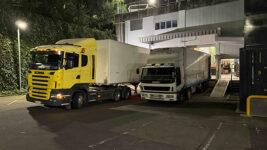ARTISTIC
10 Sep 2024
The Electric Canvas Brings Celebrated Artist’s Work to Life

Subscribe to CX E-News
Architectural projection specialists, The Electric Canvas, combine both artistic and technical expertise under the one roof to deliver complete turnkey solutions for their client’s projects. The company is well-known for blurring the lines between technical proficiency and creative flair.
TEC’s creative scopes can range from designing a solitary but impactful static image for the Sydney Opera House sails to commemorate an official occasion, to producing a fully animated narrative son et lumière for the likes of Federation Square or Brisbane City Hall.



In addition to creating original content, the company has had the pleasure of collaborating with commissioned artists, both established and emerging, from all genres and backgrounds, to help realise their vision onto some of our country’s most iconic buildings. These artists have included such celebrated names as Yayoi Kusama, Reko Rennie, Lindy Lee, Poh Ling Yeow, Marie Clarke and Tony Albert. Most had no experience with projection mapping prior to working with The Electric Canvas.
TEC is often entrusted with adapting an artist’s existing works for architectural projection, a process that must be carried out with great consideration and care. Massaging artistic assets from existing collections into rigid and sometimes unforgiving architectural canvasses requires a careful approach to the architectural form and how it interacts with the viewer. Great respect and understanding of the represented artwork must be maintained throughout the process. Although the art may be physically influenced by the architecture onto which it will be projected, the original intent of the artist must always be preserved.

For this year’s Enlighten Festival in Canberra, The Electric Canvas was engaged to create such a unique work for the façade of the National Gallery of Australia in collaboration with Archibald Prize winning artist, Vincent Namatjira OAM. Entitled ‘Indigenous All Stars’, the projection work coincided with and celebrated Namatjira’s exhibition inside the gallery, ‘Vincent Namatjira: Australia in Colour’.

The ambitious project, supported by TEC’s ultra-high resolution technical installation, brought Namatjira’s vision to life through light, movement and sound. TEC’s creative team was tasked with transforming the artist’s vibrant paintings into a projection work to illuminate the gallery’s 60-metre brutalist style façade.
The artist himself was asked to create a bespoke background painting using a special large-scale building template supplied by TEC. This background was then pathed, dissected and “healed” into separate complete layers of mountains, hills and trees that could then be animated to create depth and perspective.

From the outset, TEC’s artists knew that realising a project of such grand scale would require overcoming significant technical challenges. The assets provided were of enormous pixel dimensions, which was essential for maintaining clarity at such a large size. This resulted in significantly extended rendering times. To stay true to Namatjira’s original compositions, the backgrounds of the artworks needed to be extended and areas that were cropped or concealed in the original paintings had to be added. This process involved painstaking deep-etching, illustration and rigging, to ensure that each and every detail remained faithful to the source material. One such scene featured football players breaking out of their picture frames and joining a game of footy on the façade. This required the addition of limbs and features that were not part of the original art.

Arguably the most complex aspect of the project was the building itself. Far from a simple, contiguous flat surface, the building’s sharp angles and negative space threatened to disrupt the flow of the animation. Ensuring a consistent and fluid visual experience required meticulous planning and execution to ensure it seamlessly navigated the gallery’s complex architectural features, taking into account wildly varying audience viewpoints. This was especially important in the football scene, which saw players running across several vertical columns, achieving the illusion of a continuous image while overcoming the obstacles of physical gaps, varying depths and architectural angles.

Throughout the project, TEC worked in close collaboration with Namatjira and his team to ensure the projection captured the essence of his work in a dynamic, larger-than-life format. The movement and colour palette were aligned with an evocative original score, composed by Namatjira and Jeremy Whiskey. Every decision, from the timing of animations to the interplay of colours, was made with the artist’s vision at the forefront.
Seeing ‘Indigenous All Stars’ come to life on the façade of the National Gallery was a moment of immense pride for The Electric Canvas’ team. The projection was more than just a display – it was a living, breathing embodiment of Namatjira’s celebration of Indigenous leadership and excellence. Bringing these powerful portraits to life in such a public and impactful way was a testament to the exacting process and creative dedication that went into the project.

The artist was thrilled with the final result, so much so that he commissioned The Electric Canvas to adapt the architectural version of ‘Indigenous All Stars’ into a single-channel screen piece for display in an upcoming gallery exhibition. TEC was tasked with the challenge of condensing the NGA piece (some 12,000 wide by 4,000 pixels high) down to the size of a standard screen. Although it was impossible to keep each and every one of the subjects contained in the original work, it was vital that the integrity of the original show remained intact. Namatjira identified the characters and features he felt were essential to the work’s narrative and intent. Then TEC’s artists reworked the hundreds of assets and layers composited together for the NGA’s architecture to produce a new rendition of ‘Indigenous All Stars’ that the artist will be able to share with admirers of his work for years to come.
Subscribe
Published monthly since 1991, our famous AV industry magazine is free for download or pay for print. Subscribers also receive CX News, our free weekly email with the latest industry news and jobs.
Recent posts






